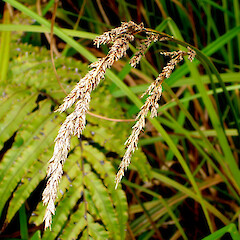Carex sectoides
Common name
sedge
Synonyms
Carex appressa R.Br. var. sectoides Kük.; Carex secta Boot var. sectoides (Kük.) Cheeseman
Family
Cyperaceae
Flora category
Vascular – Native
Endemic taxon
Yes
Endemic genus
No
Endemic family
No
Structural class
Sedges
Chromosome number
2n = c.64-68
Current conservation status
The conservation status of all known New Zealand vascular plant taxa at the rank of species and below were reassessed in 2017 using the New Zealand Threat Classification System (NZTCS) – more information about this can be found on the NZTCS website. This report includes a statistical summary and brief notes on changes since 2012 and replaces all previous NZTCS lists for vascular plants.
Please note, threat classifications are often suggested by authors when publications fall between NZTCS assessment periods – an interim threat classification status has not been assessed by the NZTCS panel.
- Conservation status of New Zealand indigenous vascular plants, 2017 . 2018. Peter J. de Lange, Jeremy R. Rolfe, John W. Barkla, Shannel P. Courtney, Paul D. Champion, Leon R. Perrie, Sarah M. Beadel, Kerry A. Ford, Ilse Breitwieser, Ines Schönberger, Rowan Hindmarsh-Walls, Peter B. Heenan and Kate Ladley. Department of Conservation. Source: NZTCS and licensed by DOC for reuse under the Creative Commons Attribution 4.0 International licence.
2017 | At Risk – Naturally Uncommon | Qualifiers: RR
Previous conservation statuses
2012 | At Risk – Naturally Uncommon | Qualifiers: RR
2009 | Not Threatened
2004 | Not Threatened
Distribution
Endemic. Chatham and Antipodes Island groups.
Habitat
Widespread along stream, lake and pond margins and in seepages, flushes, and around shallow ephemeral pools. Usually in open, well lighted situations but also may be fringing streams running through successional forest.
Wetland plant indicator status rating
Information derived from the revised national wetland plant list prepared to assist councils in delineating and monitoring wetlands (Clarkson et al., 2021 Manaaki Whenua – Landcare Research Contract Report LC3975 for Hawke’s Bay Regional Council). The national plant list categorises plants by the extent to which they are found in wetlands and not ‘drylands’. The indicator status ratings are OBL (obligate wetland), FACW (facultative wetland), FAC (facultative), FACU (facultative upland), and UPL (obligate upland). If you have suggestions for the Wetland Indicator Status Rating, please contact: [Enable JavaScript to view protected content]
OBL: Obligate Wetland
Almost always is a hydrophyte, rarely in uplands (non-wetlands).
Detailed description
Robust, tussock forming sedge up to 2 × 1 m, arising from a stout trunk-like base (comprised of densely interwoven former roots) up to 1 m tall. Culms 0.15–1.8 m × 2–3 mm, triquetrous, margins razor sharp, scabrid, robust, curved over toward apices; basal sheaths grey-brown. Leaves = to or < culms, 5–8 mm wide, deeply channelled, with strongly scarbid, razor-sharp margins. Inflorescence a broad, heavy, greyish-brown to brown panicle 70–80 mm long, with numerous stiff, crowded branchlets up to 40 mm long, the lowermost usually distant. Spikes numerous, more or less sessile, red-brown, 4–5-flowered, male flowers at apex. Glumes > utricles, ovate-lanceolate, acute or lower glumes of spike awned, brownish-hyaline, faintly nerved, with a paler brown thickened midrib. Utricles 2.5–3.8 × 1–1.8 mm, unequally biconvex, elliptic-ovoid, smooth on curved face, very faintly nerved on the flatter face, light yellow-brown, later dark brown, more or less shining; beak 1 mm long, strongly bifid, with green, winged, strongly scabrid on margins; stipe 0.5 mm long. Stigmas 2. Nut slightly < 2 mm long, biconvex, narrow-obovoid, pale grey, greyish-white to white.
Similar taxa
Allied to C. secta Boott from which it differs by its much larger, stouter over all habit, and denser more rigid, crowded inflorescences with shorter branchlets. On Chatham (Rekohu) Island C. sectoides is symaptric with C. secta.
Flowering
September–December
Fruiting
December–June
Life cycle
Nuts surrounded by inflated utricles are dispersed by granivory and wind (Thorsen et al., 2009).
Propagation technique
Easily grown from fresh seed and rooted pieces. Prefers cool climate and does best in standing water. Does not tolerate humidity or drought. On account of the very sharp leaf and culm margins care is needed when handling this sedge.
Etymology
carex: Latin name for a species of sedge, now applied to the whole group.
Where To Buy
Not commercially available
Attribution
Fact Sheet prepared by P.J. de Lange (10 August 2006). Description adapted from Moore and Edgar (1970)
References and further reading
Moore LB, Edgar E. 1970. Flora of New Zealand, Volume II. Indigenous Tracheophyta: Monocotyledones except Gramineae. Government Printer, Wellington, NZ. 354 p.
Thorsen MJ, Dickinson KJM, Seddon PJ. 2009. Seed dispersal systems in the New Zealand flora. Perspectives in Plant Ecology, Evolution and Systematics 11: 285–309.
NZPCN Fact Sheet citation
Please cite as: de Lange, P.J. (Year at time of access): Carex sectoides Fact Sheet (content continuously updated). New Zealand Plant Conservation Network. https://www.nzpcn.org.nz/flora/species/carex-sectoides/ (Date website was queried)



